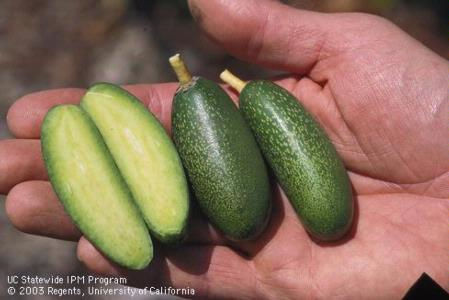
Water Quality and Southern California Agriculture
Assessing water quality for Southern California agriculture typically revolves around the total salinity of the water, its total dissolved solids (TDS), and the toxic ions boron, sodium and chloride. Salts are necessary to plants, because it is in the form of diluted salts that all nutrients are taken up by plants- the macro and micronutrients plants extract from the soil. High salinity leads to water imbalance problems much as if the plant were not getting adequate water. A toxicity problem is different from a salinity problem, in that toxicity is a result of damage within the plant rather than a water shortage. Toxicity results when the plant takes up the toxic ions and accumulates the ions in the leaf. The leaf damage that occurs from both toxicity and salinity are similar in that it causes tissue death known commonly as "tip burn." The damage that occurs depends on the concentration of the ions in the soil water around the roots, the crop sensitivity and crop water use, and the length of time the crop experiences the ions. In many cases, yield reduction occurs. Because crops can not excrete salts the way humans do, salts gradually accumulate in a plant. As a result plants need a higher water quality than humans do.
Much study in many countries has gone into evaluating water for crop use. Some of these studies have been on the effects of salts on soil characteristics. Generally, as sodium concentration increases, a soil will lose its aggregation, eventually leading to poor water infiltration. Many more salinity and toxicity studies have been done on plants themselves. Not all crops are equally tolerant of salinity and toxicities, and in general most plants respond to salinity and toxicities in a similar fashion. If a plant is intolerant of salinity, it will be intolerant of chloride, sodium and boron. Most annual crops are less sensitive to salts than tree crops and woody perennials, although symptoms can appear on any crop if concentrations are high enough. The reason for greater sensitivity for perennial crops is that the tree is sitting in the ground absorbing salts for a longer period than the lettuce plant that is harvested 3 months after planting. Furthermore, deciduous trees like walnut shed their leaves each winter, so they can handle salinity better than evergreens like citrus and avocado.
To manage salinity and toxicities, water management is the key. Depending on water quality, an excess of water will be applied to the soil to leach the previously applied salts away from the root zone. The poorer the water quality, the more excess water is applied.
Selecting a less sensitive crop is also an alternative when dealing with poor water quality. Some barley varieties can handle salinity similar to ocean water. Barley nets a grower $400 an acre, avocados $9,000 and $25,000 if the market is right for strawberries. Avocados are salt sensitive, so are strawberries and lemons and cherimoyas and star fruit and blueberries and raspberries and mandarins and nursery crops. We grow these because with our climate, very few other places can grow them and they return enough money for a grower to stay in business in an area where land, water and labor are expensive. We really don't have much in "alternative crops" to grow here.

avocado fruit
